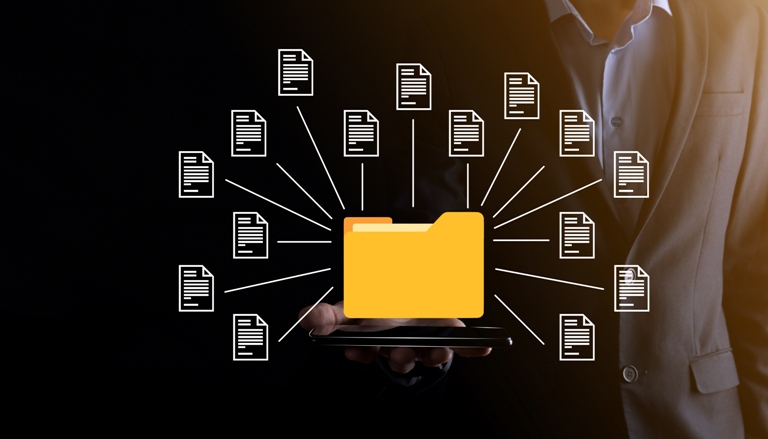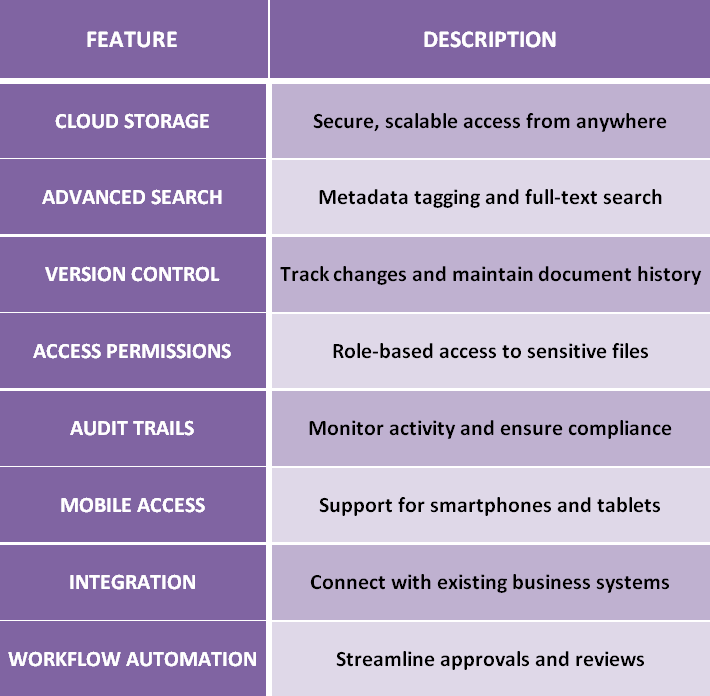
In today’s fast-paced, data-driven world, businesses are inundated with a lot of documents from contracts and invoices to employee records and compliance forms. Managing this avalanche of paperwork manually is not only inefficient but also risky. Enter the Digital Document Management System (DDMS), a transformative solution that empowers diverse businesses to streamline operations, enhance security, and boost productivity.
Whether you’re a startup aiming to scale or an enterprise seeking operational excellence, adopting a DDMS is no longer optional; it’s essential.
What Is a Digital Document Management System, Actually?
A Digital Document Management System is a software platform that enables organizations to store, manage, track, and retrieve digital documents. It replaces traditional paper-based systems with a centralized, searchable, and secure digital repository.
Key features typically include:
- Document capture and scanning
- Metadata tagging and indexing
- Version control
- Access permissions
- Audit trails
- Integration with other business systems
The Paper Problem: Why Traditional Document Management Fails
Despite the digital revolution, many businesses still rely on paper-based processes. This reliance comes at a cost:
- Time Wasted: Employees spend an average of 18 minutes searching for a single document.
- Storage Costs: Filing cabinets and off-site storage facilities consume valuable space and resources.
- Security Risks: Paper documents are always vulnerable to theft, loss, and damage.
- Compliance Challenges: Manual tracking makes it difficult to meet regulatory requirements.
According to AIIM (Association for Intelligent Information Management), 60% of organizations say they are struggling to manage unstructured information, and 70% would fail within 3 weeks if they lost their paper records in a disaster.
Going Paperless: A Strategic Move toward Sustainability
In the age of climate consciousness and corporate responsibility, businesses are often increasingly expected to reduce their environmental footprint. One of the most impactful steps a business organization can take is transitioning to a paperless environment, a shift made seamless with a Digital Document Management System (DDMS).
Going paperless isn’t just about convenience; it’s a strategic move that aligns operational efficiency with sustainability goals.
Environmental Impact of Paper-Based Operations
The traditional reliance on paper has significant ecological consequences:
- Deforestation: The paper industry is one of the largest consumers of wood, contributing to deforestation and biodiversity loss.
- Water and Energy Consumption: Producing one ton of paper requires 20,000 gallons of water and emits over 1.5 tons of CO₂.
- Waste Generation: Offices generate massive amounts of paper waste, much of which ends up in landfills.
- Chemical Pollution: Paper production involves bleaching and other chemical processes that pollute air and water.
By going paperless, businesses directly reduce their contribution to these environmental issues.
Also Read: Why Electronic Document Management Is the Future of Paperless Businesses in 2025
Benefits of Going Paperless with a DDMS
a. Reduced Carbon Footprint
Digitizing documents eliminates the need for printing, shipping, and storing paper—activities that consume fossil fuels and emit greenhouse gases.
Statistics: A company that reduces paper usage by 50% can cut its carbon footprint by over 1,000 pounds of CO₂ annually.
b. Conservation of Natural Resources
Going paperless means fewer trees are cut down, less water is used, and less energy is consumed.
Statistics: Saving one ton of paper prevents the loss of 17 trees, 7,000 gallons of water, and 463 gallons of oil.
c. Minimized Waste and Pollution
Digital documents don’t require ink, toner, or physical disposal, reducing landfill waste and chemical pollution.
Statistics: Offices that go paperless reduce waste generation by up to 80%, contributing to cleaner ecosystems.
d. Improved Energy Efficiency
Digital systems streamline workflows and reduce the need for energy-intensive equipment like printers, copiers, and filing cabinets.
Statistics: Businesses report a 30% reduction in energy costs after transitioning to digital document management.
e. Support for Green Certifications
Going paperless helps businesses qualify for sustainability certifications such as:
- LEED (Leadership in Energy and Environmental Design)
- ISO 14001 (Environmental Management Systems)
- B Corp Certification
These credentials enhance brand reputation and attract eco-conscious customers and investors.
Aligning with Global Sustainability Goals
Adopting a DDMS supports broader environmental initiatives, including:
- UN Sustainable Development Goals (SDGs): Especially Goal 12 (Responsible Consumption & Production) and Goal 13 (Climate Action).
- Corporate ESG Strategies: Environmental, Social, and Governance frameworks increasingly prioritize digital transformation as a sustainability lever.
- Net-Zero Commitments: Reducing paper use contributes to carbon-neutrality targets.
A Win-Win for Business and the Planet
Going paperless isn’t just good for the environment, it’s good for business:
- Lower operational costs
- Improved employee productivity
- Enhanced data security
- Stronger brand reputation
With a robust DDMS like SFTDOX, businesses can digitize their workflows, reduce waste, and demonstrate a genuine commitment to sustainability.
Benefits of a Digital Document Management System
Let’s explore the transformative advantages of implementing a DDMS across your organization.
a. Increased Productivity
- Employees can retrieve documents in seconds using keyword search and metadata filters.
- Automated workflows eliminate bottlenecks in approvals, reviews, and updates.
- Collaboration becomes seamless with real-time access across teams and locations.
Statistics: Businesses report a 30–50% reduction in document retrieval time after implementing a DDMS.
b. Cost Efficiency
- Reduces expenses related to printing, copying, and physical storage.
- Minimizes labor costs associated with manual filing and retrieval.
- Prevents costly errors and duplication.
Statistics: Companies can save up to $20 per document in labor costs by digitizing their document processes.
c. Enhanced Security and Compliance
- Role-based access controls ensure only authorized personnel can view or edit sensitive documents.
- Encryption and secure cloud storage protect against data breaches.
- Audit trails provide transparency and accountability.
Statistics: 76% of businesses cite improved compliance as a key benefit of DDMS adoption.
d. Disaster Recovery and Business Continuity
- Cloud-based backups ensure data is safe from fire, floods, or theft.
- Redundancy and failover systems guarantee uptime and accessibility.
Statistics: Organizations with DDMS recover from disasters 60% faster than those with paper-based systems.
e. Remote Access and Mobility
- Employees can access documents from any device, anywhere in the world.
- Mobile apps and browser-based platforms support hybrid and remote work models.
Statistics: 67% of companies say mobile access to documents has improved team collaboration.
f. Scalability and Integration
- DDMS platforms grow with your business, accommodating increasing volumes of data.
- Seamless integration with CRM, ERP, HRMS, and other systems enhances workflow efficiency.
Statistics: Integrated DDMS solutions improve cross-functional collaboration by 45%.
Industry-Specific Use Cases
- Healthcare: Hospitals and clinics use DDMS to manage patient records, prescriptions, and billing information. This ensures HIPAA compliance, reduces errors, and improves patient care.
- Legal: Law firms handle vast volumes of contracts, case files, and court documents. DDMS ensures secure storage, version control, and quick retrieval, which are critical for litigation and client service.
- Manufacturing: From blueprints to compliance documents, manufacturers rely on DDMS to maintain quality control and streamline supply chain documentation.
- Education: Schools and universities use DDMS to manage student records, faculty files, and administrative paperwork, reducing overhead and improving access.
- Finance: Banks and financial institutions use DDMS to manage customer records, loan documents, and compliance reports. This enhances security and speeds up service delivery.
Also Read: How Digital Document Management System Helps To Transform Businesses?
How DDMS Transforms Key Business Functions?
a. Human Resources
- Store employee records, resumes, and performance reviews securely.
- Automate onboarding and offboarding workflows.
- Ensure compliance with the labor laws and data protection regulations.
b. Sales and Marketing
- Manage contracts, proposals, and campaign assets.
- Track revisions and approvals with version control.
- Collaborate across teams with shared access.
c. Operations
- Digitize purchase orders, invoices, and inventory records.
- Streamline procurement and vendor management.
- Improve visibility and reduce errors.
d. Legal and Compliance
- Maintain audit trails and document history.
- Ensure timely updates to policies and procedures.
- Facilitate internal and external audits.
Features to Look for in a Digital Document Management System
When choosing a DDMS, consider the following must-have features:

Market Trends and Future Outlook
The global document management system market is booming:
- Valued at $5.5 billion in 2020, projected to reach $11.47 billion by 2026.
- Growth driven by cloud adoption, remote work, and regulatory demands.
- AI and machine learning are enhancing search, classification, and automation capabilities.
Trend: AI-powered DDMS platforms are emerging, offering intelligent document classification, predictive analytics, and smart search.
How a Digital Document Management System Ensures Regulatory Compliance?
In today’s regulatory landscape, businesses face increasing pressure to comply with industry standards, data protection laws, and internal governance policies. Non-compliance can result in hefty fines, legal consequences, and reputational damage. A Digital Document Management System (DDMS) plays a pivotal role in helping organizations meet these obligations efficiently and securely.
a. Centralized and Secure Document Storage
A DDMS stores all documents in a centralized repository with robust security protocols, including:
- End-to-end encryption to protect sensitive data
- Multi-factor authentication for user access
- Role-based permissions to restrict access to confidential files
This ensures that only authorized personnel can view, edit, or share documents—critical for compliance with laws like GDPR, HIPAA, and SOX.
b. Audit Trails and Document History
Regulators often require proof of document handling and changes. DDMS platforms automatically log:
- Who accessed a document
- What changes were made
- When actions occurred
These audit trails provide transparency and accountability, making it easier to pass audits and demonstrate compliance.
c. Retention Policies and Automated Archiving
Many regulations mandate that documents be retained for specific periods. A DDMS allows businesses to:
- Set custom retention schedules
- Automatically archive or delete documents after expiration
- Avoid accidental deletion or premature disposal
This helps organizations comply with standards like ISO 9001, FINRA, and SEC requirements.
d. Version Control and Document Integrity
Maintaining the integrity of documents is essential for compliance. DDMS platforms offer:
- Version control to track edits and prevent unauthorized changes
- Read-only modes for finalized documents
- Digital signatures to authenticate approvals
This ensures that the latest, approved version of a document is always accessible and verifiable.
e. Geographic Compliance and Data Residency
For multinational businesses, data residency laws require that certain data be stored within specific geographic boundaries. A cloud-based DDMS can:
- Offer region-specific data centers
- Comply with local data protection laws
- Provide geo-fencing options for sensitive information
This is especially important for compliance with EU GDPR, India’s DPDP Act, and California’s CCPA.
f. Policy Enforcement and User Training
A DDMS can be configured to enforce internal policies by:
- Requiring users to complete compliance checklists
- Blocking uploads of non-compliant documents
- Sending alerts and reminders for policy updates
Some systems even integrate with Learning Management Systems (LMS) to provide training modules on compliance topics.
Thus, a Digital Document Management System is not just a tool for organizing files; it’s a strategic asset for ensuring regulatory compliance. By automating critical processes, securing sensitive data, and providing transparency, a DDMS helps businesses avoid legal pitfalls and build trust with stakeholders.
Why SFTDOX Is the Ideal DDMS for Your Business?
SFTDOX is a next-generation Digital Document Management System designed to meet the needs of modern businesses. Here’s why it stands out:
Key Features
- Secure Cloud Storage: End-to-end encryption and multi-factor authentication.
- AI-Powered Search: Find documents instantly using smart filters and tags.
- Custom Workflows: Tailor approval processes to your business needs.
- Real-Time Collaboration: Share and edit documents with team members across locations.
- Compliance Tools: Built-in support for GDPR, HIPAA, and ISO standards.
a. Seamless Integration
SFTDOX integrates effortlessly with:
- Microsoft 365
- Google Workspace
- Salesforce
- SAP
- Dropbox
b. Mobile-Friendly
Access your documents on the go with SFTDOX’s intuitive mobile app perfect for remote teams and field operations.
c. Customer Support
SFTDOX offers 24/7 support, onboarding assistance, and training resources to ensure a smooth transition.
In conclusion
The shift to digital is inevitable and businesses that embrace it early gain a competitive edge. A Digital Document Management System is more than just a tool; it’s a strategic asset that drives efficiency, security, and growth.
From reducing operational costs to enhancing collaboration and compliance, the benefits are clear. Whether you’re looking to reduce costs, improve compliance, or empower your remote workforce, SFTDOX has the tools you need to succeed. Don’t let outdated paper processes hold you back.
Make the smart move. Go digital. Explore SFTDOX and take the first step toward a paperless future.









